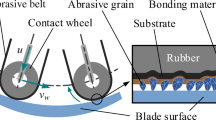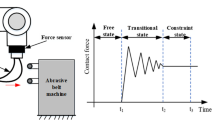Abstract
Due to the characteristics of thin-walled curved surface, wall thickness variations, and cantilevered machining fixtures, the mechanical state of the different contact positions of aircraft engine blades varies significantly during the grinding process. The different contact interactions between the contact wheel and the blade lead to changes in material removal efficiency and surface quality. To achieve contact state control during the blade grinding process, a novel flexible abrasive belt grinding device was designed and developed, taking into account the compliance of the rubber wheel. The significant effect of compliance parameters on the grinding contact state was verified through simulation. The grinding contact pressure distribution and normal contact force at different positions in the blade width and length directions were studied, and a prediction model for the maximum contact pressure and normal contact force was established based on back propagation neural networks. The results showed that with the increase in contact wheel compliance, the effective contact range increased; the pressure distribution gradually became uniform, and showed a double-elliptical distribution. The maximum contact pressure was significantly reduced, with a reduction of up to 46.00%. As the grinding contact position moved towards the weak rigidity area of the blade, the contact pressure distribution became more uniform. The normal contact force was significantly reduced, with a maximum reduction of 68.49%. The mean average percentage error (MAPE) of the prediction model was small, verifying the effectiveness of the model. The research results of this manuscript laid a foundation for achieving consistent control of the blade grinding material removal rate through contact wheel compliance adjustment.

















Similar content being viewed by others
References
Huang Y, **ao GJ, Zou L (2019) Current situation and development trend of robot precise belt grinding for aero-engine blade. Acta Aeronautica et Astronautica Sinica 40(3):48–67
Zhu DH, Xu XH, Jiang C, Li WL (2121) Research progress in robotic grinding technology for complex blades. Acta Aeronautica et Astronautica Sinica 42(10):8–30
Huang Y, Hou MM, Liu Y, **ao GJ, Zhang YD, Song KK (2020) Robotic floating belt grinding technology and experimental study on aero-engine titanium alloy blade. Aeronautical Manuf Technol 63(5):14–19
Chen G, Yang JZ, Yao KW, **ang H, Liu H (2023) Robotic abrasive belt grinding with consistent quality under normal force variations. Int J Adv Manuf Technol 125(7–8):3539–3549. https://doi.org/10.1007/S00170-023-10940-1
Jia HL, Lu XH, Cai DL, **ang YJ, Chen JH, Bao CL (2023) Predictive modeling and analysis of material removal characteristics for robotic belt grinding of complex blade. Appl Sci 13(7):4248. https://doi.org/10.3390/APP13074248
Fan WG, Wang WX, Hou GY, Wang XH (2020) Macro contact pressure modeling and simulation for rail grinding with abrasive belt based on curvature match. J Mech Eng 56(02):154–162
Xu XH, Chen W, Zhu DH, Yan SJ, Han D (2021) Hybrid active/passive force control strategy for grinding marks suppression and profile accuracy enhancement in robotic belt grinding of turbine blade. Robot Comput Integr Manuf 67:102047. https://doi.org/10.1016/j.rcim.2020.102047
Wang QL, Wang W, Zheng LY, Yun C (2021) Force control-based vibration suppression in robotic grinding of large thin-wall shells. Robot Comput Integr Manuf 67:102031. https://doi.org/10.1016/j.rcim.2020.102031
Wang ZL, Zou L, Luo GY, Lv C, Huang Y (2020) A novel selected force controlling method for improving robotic grinding accuracy of complex curved blade. ISA Trans 129:642–658. https://doi.org/10.1016/J.ISATRA.2021.12.032
Kara F, Köklü U, Kabasakaloğlu U (2020) Taguchi optimization of surface roughness in grinding of cryogenically treated AISI 5140 steel. Mater Test 62(10):1041–1047. https://doi.org/10.1515/MT-2020-621013
Li FP, Xue Y, Zhang ZY, Song WL, **ang JW (2020) Optimization of grinding parameters for the workpiece surface and material removal rate in the belt grinding process for polishing and deburring of 45 steel. Appl Sci 10(18):6314. https://doi.org/10.3390/APP10186314
Awale AS, Vashista M, Yusufzai MZK (2020) Multi-objective optimization of MQL mist parameters for eco-friendly grinding. J Manuf Process 56:75–86. https://doi.org/10.1016/j.jmapro.-2020.04.069
Zhang T, Yu Y, Yang LX, **ao M, Chen SY (2020) Robot grinding system trajectory compensation based on co-kriging method and constant-force control based on adaptive iterative algorithm. Int J Precis Eng Manuf 21:1637–1651. https://doi.org/10.1007/s12541-020-00367-z
**ao GJ, Chen SL, Song KK, Liu XT, Huang Y (2022) A novel trajectory planning method based on reverse compensation of profile error for robotic belt grinding of blisk. J Manuf Process 84:508–521. https://doi.org/10.1016/j.jmapro.2022.10.026
Zhang HY, Li L, Zhao JB, Zhao JC (2021) The hybrid force/position anti-disturbance control strategy for robot abrasive belt grinding of aviation blade base on fuzzy PID control. Int J Adv Manuf Technol 114(11–12):3645–3656. https://doi.org/10.1007/s00170-021-07122-2
Xu XH, Zhu DH, Zhang HY, Yan SJ, Ding H (2019) Application of novel force control strategies to enhance robotic abrasive belt grinding quality of aero-engine blades. Chin J Aeronaut 32(10):2368–2382
Xu XH, Chen W, Zhu DH, Yan SJ, Ding H (2021) Hybrid active/passive force control strategy for grinding marks suppression and profile accuracy enhancement in robotic belt grinding of turbine blade. Robot Comput Integr Manuf 67:102047. https://doi.org/10.1016/j.rcim.2020.102047
Zhang T, **ao M, Zou YB, **ao JD (2020) Robotic constant-force grinding control with a press-and-release model and model-based reinforcement learning. Int J Adv Manuf Technol 106(1):589–602. https://doi.org/10.1007/s00170-019-04614-0
Khalick Mohammad AE, Hong J, Wang DW (2017) Polishing of uneven surfaces using industrial robots based on neural network and genetic algorithm. Int J Adv Manuf Technol 93(1):1463–1471. https://doi.org/10.1007/s00170-017-0524-6
Chen F, Zhao H, Li DW, Chen L, Tan C, Ding H (2019) Contact force control and vibration suppression in robotic polishing with a smart end effector. Robot Comput Integr Manuf 57:391–403. https://doi.org/10.1016/j.rcim.2018.12.019
Arunachalam APS, Idapalapati S, Subbiah S, Lim YW (2020) A novel retractable stiffener-based disk-shaped active compliant polishing tool. J Manuf Process 51:83–94. https://doi.org/10.1016/j.jmapro.2020.01.025
Duan JH, Zhou ZW, An JL, Gao F, Li Y, Huai WB (2023) Research on contact characteristics of belt grinding of aero-engine blade based on compliance adjustment of contact wheel. Journal of Mechanical Engineering. http://kns.cnki.net/kcms/detail/11.2187.TH.20230428.1445.032.html. Accessed 4 May 2023
Chen JZ, Huang MX, Wang XR, Wang T (2015) Typical constitutive models of rubber materials and their ranges of application. Mater Rep 29(S1):118–120 (+124)
Ismailov VE (2014) On the approximation by neural networks with bounded number of neurons in hidden layers. J Math Anal Appl 417(2):963–969. https://doi.org/10.1016/j.jmaa.2014.03.092
Funding
This work was supported by the Natural Science Basic Research Program of Shaanxi (grant numbers 2023-JC-YB-434 and 2022JM-240) and the Key Research and Development Program of Shaanxi (grant number 2021ZDLGY09-01).
Author information
Authors and Affiliations
Contributions
All authors contributed to the study conception and design. Material preparation, data collection, and analysis were performed by Jihao Duan, Zhuofan Wu, and Jiale An. Dou Wang, Feng Gao, and Wenbo Huai participated in carrying out grinding experiments. The first draft of the manuscript was written by Jihao Duan, and all authors commented on previous versions of the manuscript. All authors read and approved the final manuscript.
Corresponding author
Ethics declarations
Competing interests
The authors declare no competing interests.
Additional information
Publisher's Note
Springer Nature remains neutral with regard to jurisdictional claims in published maps and institutional affiliations.
Rights and permissions
Springer Nature or its licensor (e.g. a society or other partner) holds exclusive rights to this article under a publishing agreement with the author(s) or other rightsholder(s); author self-archiving of the accepted manuscript version of this article is solely governed by the terms of such publishing agreement and applicable law.
About this article
Cite this article
Duan, J., Wu, Z., An, J. et al. Prediction of contact characteristics of abrasive belt compliant grinding for aircraft blades. Int J Adv Manuf Technol 132, 231–243 (2024). https://doi.org/10.1007/s00170-024-13363-8
Received:
Accepted:
Published:
Issue Date:
DOI: https://doi.org/10.1007/s00170-024-13363-8




